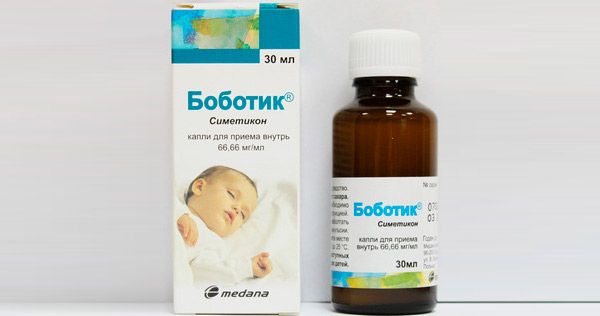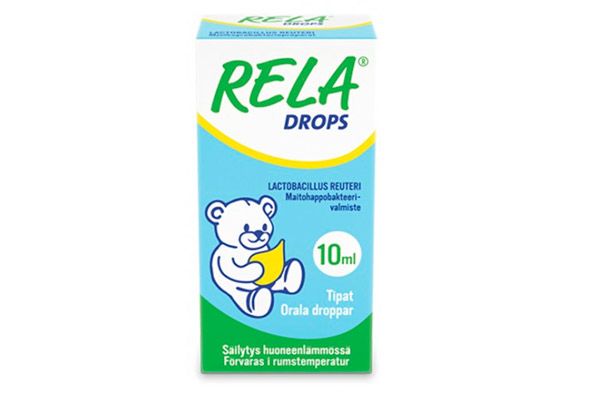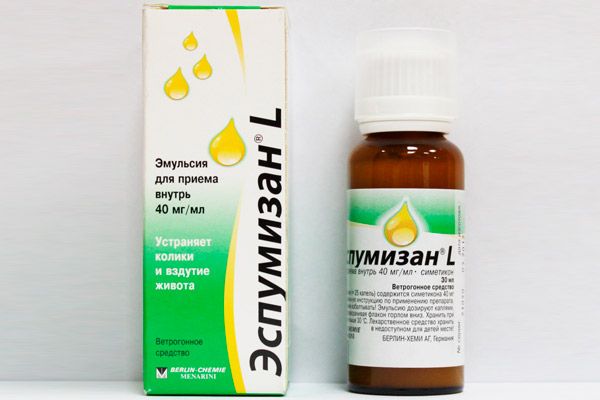Medical expert of the article
New publications
Preparations
Colic drops
Last reviewed: 04.07.2025

All iLive content is medically reviewed or fact checked to ensure as much factual accuracy as possible.
We have strict sourcing guidelines and only link to reputable media sites, academic research institutions and, whenever possible, medically peer reviewed studies. Note that the numbers in parentheses ([1], [2], etc.) are clickable links to these studies.
If you feel that any of our content is inaccurate, out-of-date, or otherwise questionable, please select it and press Ctrl + Enter.

Drops for colic used for gastrointestinal problems belong to the pharmacological group of carminative (carminative) agents that facilitate the release of gases from the intestines, the accumulation of which is accompanied by paroxysmal painful spasms. Some manufacturers classify them as agents that affect the digestive system and are used for functional intestinal disorders (ATC code - A03A) and are included in the silicone group (ATC code - A03A X13).
It should be borne in mind that these products are intended for those who have intestinal colic. In other types of colic - rectal, appendicular, renal, hepatic or pancreatic - attacks of acute pain are relieved by other drugs, that is, in such cases, drops for intestinal colic are not used.
Indications for use of colic drops
Colic drops are mainly used as a symptomatic remedy to reduce excess intestinal gas, which occurs with excessive gas formation (flatulence) of any etiology (see - Causes of flatulence ); digestive disorders (dyspepsia); due to increased air swallowing during food intake (aerophagia); in the presence of gastrocardial syndrome.
Gastroenterologists prescribe the use of drops for colic before performing instrumental and hardware diagnostics, in particular, X-rays, ultrasound and endoscopy, as well as before surgical interventions on the abdominal and pelvic organs.
In addition, indications for the use of drops for colic include poisoning with surfactants (synthetic detergents) found in detergents and other types of household chemicals.
Colic drops for newborns (aged two weeks and four months) are used for infant colic, which has the ICD-10 code R10.4 (symptoms and signs related to the digestive system and abdominal cavity). Despite the prevalence of this condition (which is observed in every fifth infant in the first three months of life), its pathogenesis remains unclear. However, the most common version of the cause of colic in infants associates them with gas accumulation in the gastrointestinal tract. This is why pediatricians recommend using colic drops for newborns.
Although, perhaps, this syndrome has a different etiology (which pediatricians all over the world are working to find out). And, perhaps, it is connected with the fact that the process of adaptation of the newborn's digestive system is underway, including the enzymatic one, which occurs in the small intestine. After all, the fetus was fed through the placenta, bypassing the gastrointestinal tract, and after the birth of the child, both the method of intake of nutrients and their absorption change radically.
Pharmacodynamics
The pharmacodynamics of Espumisan L drops, as well as all its synonyms, including the product for newborns Bobotik, is provided by the active substance simethicone. From a chemical point of view, this is polydimethylsiloxane (dimethylpolysiloxane) - silicone in liquid form, or more precisely, silicon dioxide (silica) modified by introducing methylsilyl groups.

This substance, entering the gastrointestinal tract when taken in drops, reduces the surface tension of gas bubbles, and they burst. The released oxygen is absorbed by the intestinal mucosa, and the remaining gases (methane, hydrogen sulfide, indole, skatole, mercaptan) freely leave the intestines by flatulence.
By the way, amorphous silicon dioxide in the form of antifoaming additive E551 is used against caking of powdered food products and the formation of lumps in them.
The pharmacological action of Cuplaton drops is based on their active component dimethicone (polysilane), close to the already described simethicone.
The composition of combined drops for colic for newborns Carminativum Bebinos includes alcohol (!) extracts of fennel, coriander and chamomile flowers. If fennel provides a carminative effect, then chamomile and coriander act as antispasmodics.
But the Finnish drops for colic Rela drops (Rela Colic drops) contain lactic acid bacteria Lactobacillus Reuteri and are a probiotic. The use of probiotics, that is, bacteria present in the gastrointestinal tract, is a fairly promising solution to the problem of infant colic. And this is shown by randomized controlled trials (the last one was conducted in 2014 by Finnish researchers from the University of Turku).

Pharmacokinetics
Simethicone included in Espumisan L drops, Bobotik, and dimethicone in Cuplaton drops are pharmacologically and physiologically inert substances and act solely physically, without participating in chemical reactions. At a concentration of 0.1 mg/ml, simethicone extinguishes foam in the intestinal lumens within 3-6 seconds after taking the drug, and its duration of action is about 24 hours.
After oral administration of drops containing simethicone or dimethicone, absorption and biotransformation do not occur. After passing through the gastrointestinal tract, these substances are eliminated from the body with feces.
According to official instructions, the pharmacokinetics of Carminativum Bebynos and Rela drops have not been studied.
Names of colic drops
Today, the list of products in this group includes such names of colic drops as Espumisan L, produced by the German company Berlin-Chemie AG, as well as other trade names (used by different manufacturers) with the same active ingredient: Simethicone, Simikol, Infacol, Disflatil, Sab Simplex, Phazyme, Flatulex, Mylicon. These products are synonyms.
And drops for colic for newborns are represented by the following names: Bobotik (synonyms - Espumisan, Sab Simplex), Cuplaton drops (Orion Corporation, Finland), Carminativum Bebynos (manufacturer - Dentinox Berlin, Germany), Rela Colic drops (Verman, Finland).
Choosing the best drops for colic is difficult, since their effectiveness depends on the cause of intestinal colic and the individual reaction of the body to their effects.
Method of administration and dosage
The method of using colic drops is internal (through the mouth) - during or immediately after meals. Espumisan L for flatulence in adults and children over 14 years old is prescribed 50 drops (2 ml) three times a day; for children 6-14 years old - 25-50 drops three times a day; for children 1-6 years old - 25 drops and the same amount for infants (with a small amount of liquid after feeding).

Dosages of Bobotik: for children 1-24 months - 8 drops maximum 4 times a day; 2-6 years - 14 drops, over 6 years - 16 drops.
Cuplaton drops are recommended for use: for children aged 6-12 months, 1 drop four times a day; 1-2 years old – 1-2 drops; 2-4 years old – 2 drops; 4-6 years old – 3 drops; 6-10 years old – 4 drops, and after 10 years and adults – 5 drops four times a day.
For adults and children, Finnish drops for colic Rela drops (Rela Colic drops) are prescribed 5 drops per day.
The method of application and dosage of Carminativum Bebynos drops are as follows. For infants, 3-5 drops are diluted in a tablespoon of liquid and given 2-3 times a day, for 2-6 years old, 6-10 drops per dose, and for those over 6 years old and adults, 10-15 drops three times a day.
Overdose is not indicated in the instructions for any of the described products. Nor are their interactions with other drugs.
Storage conditions include temperatures not exceeding +25°C; an opened bottle of Rela drops should be stored in the refrigerator.
Shelf life: Espumisan L and all other drops with simethicone - 3 years; Bebinos after opening the bottle is valid for 12 months.
 [ 5 ]
[ 5 ]
Contraindications for use
Colic drops Espumisan L, Bobotik, Cuplaton (Kuplaton), Carminativum Bebynos are contraindicated for use in case of individual hypersensitivity to the components of the drugs, in case of acute gastrointestinal diseases, gastrointestinal obstruction, as well as intestinal obstruction.
Bobotik is not used for children in the first month of life. The instructions do not indicate any contraindications for Finnish colic drops Rela drops (Rela Colic drops).
The use of colic drops during pregnancy requires caution. This is stated in the instructions for children's drops Bobotik. And the manufacturers of drops Espumisan L and Cuplaton note that their products can be used during pregnancy and breastfeeding.
Side effects of colic drops
Drops containing modified silicon dioxide – Espumisan L, Bobotik, etc. – can have side effects in the form of hives on the skin and itching, and when taking Cuplaton drops, in addition to allergic reactions, there may be bloating and abdominal pain.
Allergic reactions can be caused by additional substances in the composition of these drugs (including in drops for colic for newborns). These are propyl ether of hydroxybenzoic acid - the preservative propylparaben (E216), as well as methyl ether of hydroxybenzoic acid - the preservative methylparaben (E218). These additives are distinguished by their antibacterial activity, and E-218 also acts as an antiseptic, ensuring long-term storage of food and pharmaceuticals.
Attention!
To simplify the perception of information, this instruction for use of the drug "Colic drops" translated and presented in a special form on the basis of the official instructions for medical use of the drug. Before use read the annotation that came directly to medicines.
Description provided for informational purposes and is not a guide to self-healing. The need for this drug, the purpose of the treatment regimen, methods and dose of the drug is determined solely by the attending physician. Self-medication is dangerous for your health.

